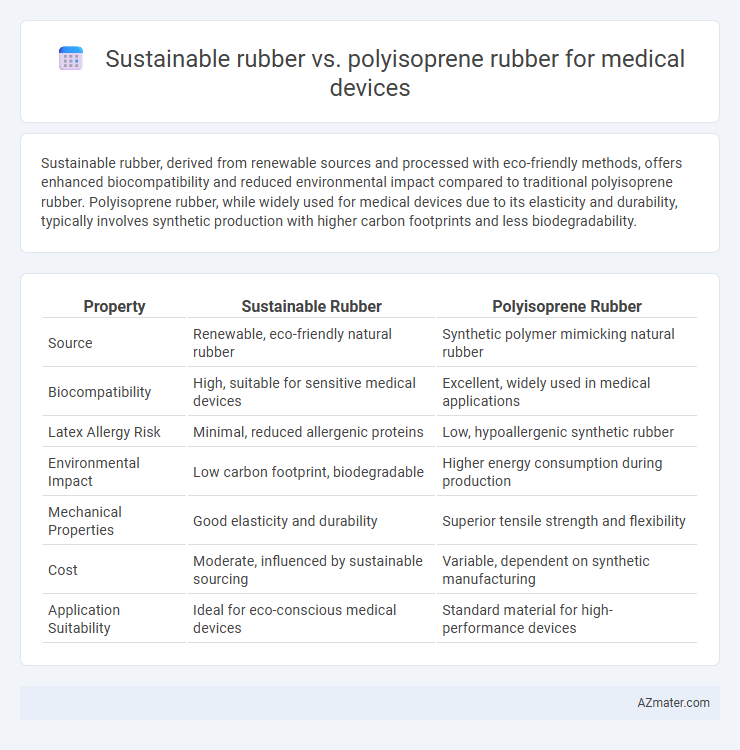Sustainable rubber, derived from renewable sources and processed with eco-friendly methods, offers enhanced biocompatibility and reduced environmental impact compared to traditional polyisoprene rubber. Polyisoprene rubber, while widely used for medical devices due to its elasticity and durability, typically involves synthetic production with higher carbon footprints and less biodegradability.
Table of Comparison
| Property | Sustainable Rubber | Polyisoprene Rubber |
|---|---|---|
| Source | Renewable, eco-friendly natural rubber | Synthetic polymer mimicking natural rubber |
| Biocompatibility | High, suitable for sensitive medical devices | Excellent, widely used in medical applications |
| Latex Allergy Risk | Minimal, reduced allergenic proteins | Low, hypoallergenic synthetic rubber |
| Environmental Impact | Low carbon footprint, biodegradable | Higher energy consumption during production |
| Mechanical Properties | Good elasticity and durability | Superior tensile strength and flexibility |
| Cost | Moderate, influenced by sustainable sourcing | Variable, dependent on synthetic manufacturing |
| Application Suitability | Ideal for eco-conscious medical devices | Standard material for high-performance devices |
Introduction to Medical-Grade Rubber Materials
Medical-grade rubber materials like sustainable rubber and polyisoprene rubber are essential in medical devices due to their biocompatibility, elasticity, and durability. Sustainable rubber, often derived from eco-friendly sources or recycled materials, offers environmental advantages while maintaining performance standards critical for medical applications. Polyisoprene rubber, a synthetic equivalent to natural latex, provides allergen-free properties and consistent quality, making it a reliable choice for sensitive medical uses such as gloves, tubing, and seals.
What Is Sustainable Rubber?
Sustainable rubber in medical devices refers to natural rubber sourced from rubber trees cultivated using eco-friendly practices that prioritize biodiversity, reduced chemical use, and responsible land management. This type of rubber offers a biodegradable and renewable alternative to synthetic polyisoprene rubber, which is chemically produced from isoprene monomers. By emphasizing sustainability, medical device manufacturers can minimize environmental impact while maintaining the biocompatibility and elasticity needed for applications like gloves, catheters, and tubing.
Understanding Polyisoprene Rubber
Polyisoprene rubber, closely mimicking natural rubber's molecular structure, offers superior elasticity and biocompatibility, essential for medical devices requiring flexibility and patient safety. Sustainable rubber alternatives often prioritize eco-friendly production but may lack the consistent purity and performance standards mandatory in critical healthcare applications. Medical-grade polyisoprene rubber ensures low allergenicity and high tensile strength, making it the preferred choice for gloves, catheters, and other sterile, flexible medical components.
Environmental Impact: Sustainable Rubber vs Polyisoprene
Sustainable rubber for medical devices significantly reduces carbon emissions and deforestation compared to traditional polyisoprene rubber, which often involves intensive synthetic processing and fossil fuel consumption. The sustainable variant promotes eco-friendly harvesting methods and supports biodiversity by utilizing renewable natural resources with minimal chemical treatments. Life cycle assessments reveal that sustainable rubber decreases water usage and waste generation, making it a greener alternative for healthcare product manufacturing.
Biocompatibility and Safety in Medical Applications
Sustainable rubber provides excellent biocompatibility and reduces environmental impact compared to traditional polyisoprene rubber in medical devices. Both materials exhibit hypoallergenic properties and compliance with ISO 10993 standards for cytotoxicity and sensitization, ensuring patient safety. Sustainable rubber's renewable sourcing and lower chemical additives further minimize potential toxicological risks in medical applications.
Performance and Durability Comparison
Sustainable rubber, derived from natural, renewable sources, offers superior biocompatibility and reduced environmental impact compared to synthetic polyisoprene rubber commonly used in medical devices. While polyisoprene rubber provides consistent mechanical properties and excellent elasticity, sustainable rubber demonstrates enhanced biodegradability and comparable tensile strength, making it suitable for long-term medical applications. Both materials exhibit strong resistance to wear and chemical degradation, but sustainable rubber's eco-friendly profile aligns with growing demands for greener medical technologies without compromising device performance and durability.
Manufacturing Processes and Resource Efficiency
Sustainable rubber, often derived from natural sources with eco-friendly harvesting methods, requires less energy-intensive processing compared to synthetic polyisoprene rubber used in medical devices, resulting in lower carbon footprint and reduced chemical waste. Polyisoprene rubber manufacturing involves polymerization of petrochemical feedstocks, which demands significant energy inputs and generates higher greenhouse gas emissions, limiting resource efficiency. Advances in sustainable rubber production emphasize renewable input utilization and closed-loop systems, enhancing overall environmental performance without compromising the stringent quality standards essential for medical device applications.
Regulatory Considerations and Certifications
Sustainable rubber, derived from eco-friendly sources, often meets stringent regulatory standards such as ISO 10993 for biocompatibility and REACH compliance, crucial for medical device approval. Polyisoprene rubber, widely recognized for its consistency and purity, complies with FDA regulations and USP Class VI certifications that ensure its safety and performance in critical medical applications. Both materials require rigorous documentation and testing to align with global standards like MDR in Europe and FDA's 21 CFR Part 820 for quality management systems.
Cost Analysis and Market Availability
Sustainable rubber for medical devices offers a competitive edge in cost analysis due to its eco-friendly sourcing and potential for lower long-term expenses through reduced regulatory compliance risks compared to polyisoprene rubber. Polyisoprene rubber benefits from established market availability, with widespread supply chains and proven performance in medical applications, but it may incur higher costs associated with non-renewable raw material fluctuations. Market trends indicate growing demand for sustainable rubber alternatives driven by regulatory pressures and consumer preference, enhancing its availability and cost-effectiveness in the medical device sector over time.
Future Trends in Medical Device Rubber Alternatives
Sustainable rubber, derived from renewable sources such as guayule and dandelions, is gaining traction as a biodegradable and eco-friendly alternative to traditional polyisoprene rubber in medical devices. Innovations in bio-based polymer synthesis and enhanced purification techniques are driving improvements in material performance and biocompatibility, facilitating broader adoption in surgical gloves, catheters, and seals. Future trends indicate increased integration of sustainable rubber with advanced antimicrobial coatings and nanocomposite enhancements, aiming to meet stringent regulatory standards while reducing the environmental footprint of medical device components.

Infographic: Sustainable rubber vs Polyisoprene rubber for Medical device
 azmater.com
azmater.com